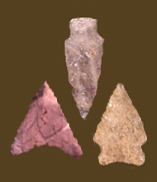
HOW ARE POINTS MADE? Stones high in silica (the main component of glass) are hard, somewhat brittle, and have a conchodial (shell-like) fracture pattern. When one strikes this type of stone at the proper angle and with adequate force, it is possible to remove a flake and create a sharp edge. By repeatedly removing flakes, one can shape the piece to create the desired form. Native Americans shaped stone by striking it with either a cobble-like tool called a hammerstone, or with an antler baton. This technique, which breaks off chips of stone, is known as “percussion flaking.” The edges of the point, as well as its stem (the portion which is fastened to a wood or bone shaft), may be sharpened and notched by using pressure to remove small flakes. This second technique, called “pressure flaking,” involved pressing a bone tool against the point to remove flakes. Native Americans also sometimes ground down the edge or base of the point. This helped to control the removal of the flakes, and reduced the risk of cutting the sinew that secured the point to the haft. Some jaspers and cherts were heat treated by Native Americans. They used fire to heat and thermally alter a rough stone tool in an attempt to improve its flaking characteristics prior to the final shaping. Heat treating the stone slowly over a long period of time at approximately 350°C alters the color, luster, and molecular structure of the stone. The appearance can change in any number of ways, but often the stone becomes darker and/or redder, with a waxier luster. Heat treating the stone reduces its tensile strength by as much as one-half, thus making it easier to flake.
Photo credit: http://museum.state.il.us/pub/dmmweb/Images/Paleo/flintknapper%20copy.jpg |
![]()
Search by Shape:
(See Projectile Point Typology) |

|
Thank you for visiting our website. If you have any
questions, comments, Copyright © 2002 by |

|

